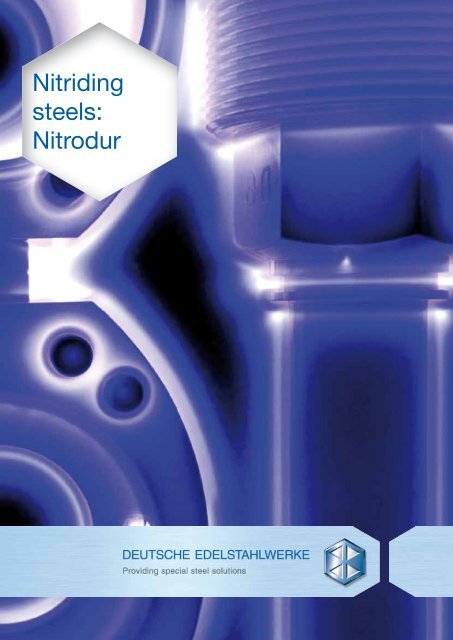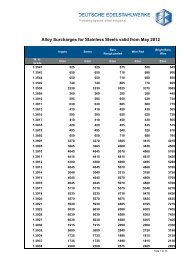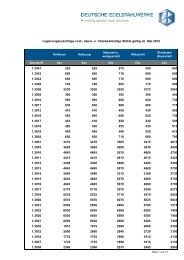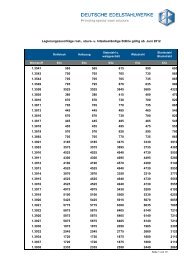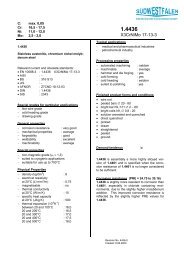Nitriding steels: Nitrodur - DEW-STAHL.COM
Nitriding steels: Nitrodur - DEW-STAHL.COM
Nitriding steels: Nitrodur - DEW-STAHL.COM
Create successful ePaper yourself
Turn your PDF publications into a flip-book with our unique Google optimized e-Paper software.
<strong>Nitriding</strong><br />
<strong>steels</strong>:<br />
<strong>Nitrodur</strong>
<strong>Nitriding</strong> <strong>steels</strong>:<br />
<strong>Nitrodur</strong><br />
<strong>Nitrodur</strong> –<br />
a speciality of Deutsche Edelstahlwerke.<br />
Whenever machines and components are subject to high<br />
surface stresses and dynamic loads, it is vitally important<br />
that special high-performance <strong>steels</strong> are used. Premium<br />
materials, like one of our <strong>Nitrodur</strong> <strong>steels</strong>, is an excellent<br />
choice for applications in which the material is subjected to<br />
high temperatures and where high surface hardness and good fatigue<br />
strength are required. Nitrided surfaces maintain their hardness and strength up to<br />
operating temperatures of approx. 500 to 550° C.<br />
02<br />
<strong>Nitrodur</strong> is the brand name of the family of<br />
nitriding <strong>steels</strong> that Deutsche Edelstahlwerke<br />
offers for use at elevated temperatures.<br />
By varying the nitriding parameters, different<br />
hardness profiles and degrees of surface<br />
hardness can be achieved. One of the advantages<br />
compared to other methods, such<br />
as case hardening, is that there is less risk of<br />
deformation since no transformation process<br />
occurs when cooling down from the nitriding<br />
temperature.<br />
The particularly high degree of purity and<br />
the homogeneity of the structure ensure<br />
consistent mechanical properties even for<br />
larger dimensions. Areas of hardness and<br />
toughness can be adjusted to the requirements<br />
of the particular component. <strong>Nitrodur</strong> <strong>steels</strong><br />
offer an excellent degree of hot work ability.<br />
Cold formability and machinability are<br />
dependent on the analysis and the type of<br />
structure. By adjusting the type of alloy and<br />
heat treatment, the material can also achieve<br />
optimal machinability.<br />
The high quality of <strong>Nitrodur</strong> <strong>steels</strong> is achieved<br />
by a high level of process control, modern<br />
facilities for melting, secondary metallurgy,<br />
continuous casting, remelting, hot working<br />
and heat treatment as well as advanced<br />
non-destructive testing facilities. Deutsche<br />
Edelstahlwerke is able to deliver a custom<br />
nitriding steel for any field of application and<br />
many different components.<br />
Consult with one of our materials experts.<br />
03
State of the art<br />
Our expertise in steel production means security for you<br />
Steel production facilities in both of our<br />
steelworks combined with additional remelting<br />
options, is the basis for the purity<br />
and homogeneity of our nitriding <strong>steels</strong>. We<br />
achieve very clearly defined properties as<br />
a result of precise specifications, process<br />
control and procedures for melting, forming<br />
and heat treatment. The <strong>steels</strong> are melted<br />
in 130 ton electric arc furnaces. Then they<br />
go through metallurgical fine-tuning in ladle<br />
furnaces of the same size. Depending on<br />
the steel grade and dimensions desired for<br />
the final product, the melted steel is cast<br />
via continuous casting or bloom casting<br />
procedures. For ingot casting, 50 different<br />
ingot mould formats from 600 kg to 40 t are<br />
available. Continuous casting is performed<br />
in a two-strand 475 x 340 mm vertical<br />
continuous casting facility or by means of a<br />
six-strand bow-type continuous caster in the<br />
sizes 138 mm and 265 mm. For tool <strong>steels</strong><br />
requiring particularly high levels of structural<br />
homogeneity, toughness, and purity, we use<br />
electroslag remelting furnaces (ESRs) and<br />
vacuum arc remelting furnaces (VARs).<br />
Electroslag Remelting<br />
During electroslag remelting (ESR), a process<br />
that involves alternating current, a cast or<br />
forged consumable electrode is immersed<br />
in molten slag which serves as an electrical<br />
resistor. The material to be remelted drips<br />
through the slag from the end of the electrode<br />
and forms the new block in the watercooled<br />
mould. The heat dissipation allows<br />
the solidification to be directed towards the<br />
longitudinal axis of the block. The remelting<br />
slag serves multiple purposes in this procedure.<br />
It generates the necessary heat,<br />
initiates chemical reactions such as desulphurisation<br />
and protects the molten bath of<br />
the newly formed block from oxidation.<br />
In addition, the slag has a high capacity<br />
for non-metallic inclusions, which results<br />
in remelted material which is then free of<br />
macro-inclusions. The improved microscopic<br />
cleanliness is due to desulphurisation<br />
and the resulting high level of sulphidic<br />
cleanliness as well as the reduced size and<br />
quantity of oxide inclusions.<br />
Vacuum Arc Remelting<br />
Vacuum arc remelting (VAR) is a procedure<br />
that involves the remelting of cast or forged<br />
consumable electrodes in a vacuum. A molten<br />
bath is created under vacuum by means of<br />
an arc in a copper pan that serves as the<br />
opposite pole for the remelting electrode<br />
and is connected to a DC power source via<br />
power contacts. In a continuous process, a<br />
new block is formed drop by drop from the<br />
liquefied electrode material. In the VAR method,<br />
the steel is refined because the oxygen<br />
released in the steel reacts with the carbon<br />
in the molten mass as a result of the vacuum.<br />
This leads to an optimal degree of microscopic<br />
oxidic cleanliness and the absence of<br />
macroscopic inclusions. Since this remelting<br />
process does not involve desulphurisation,<br />
it is important that the sulphur content is set<br />
to the lowest level possible before remelting<br />
in order to meet the requirements for sulphidic<br />
cleanliness. This method furthermore ensures<br />
the lowest possible gas content in<br />
the steel as well as a structure that is homogenous<br />
and free of segregations.<br />
Hot Forming and Finishing<br />
The ingot or continuous casting products<br />
produced in the steelworks are fed into<br />
the blooming mill via computer-controlled<br />
rotating hearth furnace and rolled into semifinished<br />
products, bar steel or products in<br />
universal plate dimensions. An inter mediate<br />
reheating furnace located after the first<br />
forming unit, facilitates rolling in very narrow<br />
temperature ranges, which allows even<br />
critical high-alloy <strong>steels</strong> to be rolled. Modern<br />
finishing lines are available for straightening<br />
semi-finished products and steel bars,<br />
where the interior quality and surface properties<br />
are examined and dimensions and<br />
identity are checked. Forging as a way of<br />
hot forming is performed in a 45 MN press,<br />
a 33 MN press and one of the world‘s largest<br />
and most efficient precision long forging<br />
machines (GFM RF 70). This machine can<br />
04 05<br />
forge products in dimensions up to approx.<br />
550 mm in diameter. A horizontal long forging<br />
machine is available for smaller dimensions.<br />
Mechanical Processing<br />
Deutsche Edelstahlwerke not only offers an<br />
optimal material in different product forms<br />
but also rough-machined and ready-to-use<br />
components. Our customers have access to<br />
extensive expertise and modern processing<br />
systems. Rolled or forged steel bars as well<br />
as round pipe blanks up to 300 mm can be<br />
peeled, pressure-polished or chamfered after<br />
straightening. In Krefeld, Germany, rotationsymmetric<br />
parts with unit weights of up to<br />
20 tons are manufactured in conventional and<br />
modern CNC lathes and grinding machines.<br />
The focus of our production is on shafts, cylinders<br />
and continuous casting guiding rollers.
<strong>Nitrodur</strong> - Hardness and Precision for Increased Safety<br />
Plastic Processing<br />
During injection, pressing and intruding, the<br />
cylinders, piston, worm gears, injection nozzles<br />
and other components are exposed to high<br />
degrees of stress. Even during increased<br />
working temperatures up to approx. 500° C,<br />
a consistently high level of hardness must<br />
be maintained in order to ensure an even<br />
degree of precision in the products to be<br />
manufactured.<br />
<strong>Nitrodur</strong> meets these requirements.<br />
Gear Manufacturing<br />
In power plant operation, rolls, gear wheels<br />
and pinions with external and internal gear<br />
improved systems manufactured from <strong>Nitrodur</strong><br />
achieve reliability and longer service lives.<br />
<strong>Nitrodur</strong> <strong>steels</strong> are also particularly suited<br />
for situations in which components cannot<br />
be reworked after heat treatment due to<br />
their geometry or small dimensions. This is<br />
because nitriding increases the surface hardness<br />
without resulting in severe distortion.<br />
Engine Construction<br />
Since engines, for example racing engines,<br />
are subject to extreme stresses, particularly<br />
thermal stresses, the use of special <strong>Nitrodur</strong><br />
<strong>steels</strong> is recommended for crank-shafts,<br />
connecting rods, pistons gears, cylinders,<br />
cylinder liners and driving chains.<br />
General Mechanical Engineering<br />
<strong>Nitrodur</strong> <strong>steels</strong> are suitable for any application<br />
in mechanical engineering that requires<br />
reliable operation and precise functioning<br />
even for high temperatures. This includes<br />
the manufacture of pump drive shafts, timing<br />
chains, pistons for hydraulic controls, worm<br />
shafts and gears, spindles, straightening rolls,<br />
super-heated steam valves, valve guides and<br />
valve seats.<br />
Toolmaking<br />
For precision parts and tools operating under<br />
elevated operating temperatures, <strong>Nitrodur</strong><br />
guarantees that the geometry of the components,<br />
such as calibrating rollers, calibration<br />
rings, thread gauges, plug gauges, gear<br />
wheels and piston rods, remains stable.<br />
06 07<br />
Machine Tool Construction<br />
<strong>Nitrodur</strong> <strong>steels</strong> guarantee a long service life,<br />
reliable functioning and consistently high<br />
precision for machine tools, such as spindles,<br />
guide rails, grinding and drilling equipment as<br />
well as milling machines and lathes.
<strong>Nitrodur</strong> - the nitriding steel by<br />
Deutsche Edelstahlwerke<br />
Surface treatment is used whenever a<br />
component is to feature a ductile core and<br />
a higher hardness on the surface combined<br />
with compressive residual stress to increase<br />
wear resistance and vibration resistance.<br />
In addition to the chemical procedure of<br />
selective surface hardening and the thermochemical<br />
procedure of case hardening, the<br />
thermo-chemical procedure of nitriding is<br />
particularly important. This procedure generally<br />
involves special nitriding <strong>steels</strong>, which<br />
are produced under the trade name <strong>Nitrodur</strong><br />
at Deutsche Edelstahlwerke.<br />
Definition of <strong>Nitriding</strong><br />
According to DIN EN 10052:1994-01, nitriding<br />
is defined as the thermo-chemical treatment of<br />
a workpiece in order to enrich the surface layer<br />
with nitrogen. Carbo-nitriding involves enriching<br />
the surface layer with nitrogen and carbon.<br />
Principle of <strong>Nitriding</strong><br />
The purpose of nitriding is to enrich the<br />
surface layer of a workpiece with nitrogen in<br />
order to increase the hardness in the surface.<br />
The process of nitriding takes advantage of<br />
the low solubility of nitrogen in the ferritic<br />
crystal structure to promote the precipitation<br />
of iron nitrides or alloy nitrides. With a<br />
nitrogen content of a few percent, a nitride<br />
layer that is mostly cohesive (connecting<br />
layer) forms on the surface. This layer is<br />
connected to a diffusion zone, in which the<br />
precipitated nitrides are evenly distributed<br />
in the steel matrix and which results in hardening,<br />
particularly for alloyed <strong>steels</strong>. Since<br />
nitrogen lowers the gamma / alpha transformation<br />
temperature of iron down to 590° C,<br />
the nitriding temperatures are generally below<br />
this temperature. The lower limit for the<br />
nitriding temperature is considered to be<br />
350° C, because below this temperature,<br />
nitrogen diffusion does not occur on a rate<br />
that can be exploited technologically or economically.<br />
As temperatures decrease, the nitriding<br />
time necessary to reach a given depth<br />
of hardness increases. The depth of nitriding<br />
hardness may reach 500 μm with maximum<br />
hardness levels of > 1000 HV. Since warming<br />
up and cooling down occurs slowly and the<br />
basic structure does not undergo any transformation<br />
or change in volume, there is only<br />
a low risk of deformation.<br />
<strong>Nitriding</strong> Steels<br />
The material of choice is generally a nitriding<br />
steel according to DIN EN 10085: 2001/7,<br />
alloyed <strong>steels</strong> with nitride-forming elements.<br />
Nitrided <strong>steels</strong> are primarily available in the<br />
soft-annealed (A) or tempered (QT) condition.<br />
08 09<br />
Formation of a Nitride Layer<br />
The nitrogen is transferred from the surrounding<br />
medium in the following steps:<br />
Adsorption of nitrogen atoms on<br />
the surface of the component<br />
Absorption of (nitrogen atoms)<br />
by the component surface<br />
Diffusion of the nitrogen atoms along<br />
the grain boundaries and within the grains<br />
Nitrides form around seed points on the surface<br />
of the component (grain boundaries and nodes<br />
at which several grains meet). As the nitrogen<br />
concentration and nitriding time increase, the<br />
nitrides grow deeper and expand laterally into<br />
the grains until a closed layer has been formed.<br />
Along with the nitride forming alloy elements,<br />
nitrides form and disperse submicroscopically<br />
in the matrix.
Composition of a Nitride Layer<br />
It is almost unavoidable that this layer<br />
displays a certain degree of porosity. This<br />
is due to a recombination to molecular<br />
nitrogen in energetically suitable spots, such<br />
as grain boundaries, in the connecting layer.<br />
The connecting layer may be brittle with a<br />
tendency to chip and is therefore removed<br />
by means of grinding in some cases. The<br />
adjacent diffusion zone affects strength characteristics<br />
(fatigue resistance) and increases<br />
resistance against rolling wear and abrasion.<br />
The composition of nitride layers may be<br />
modified significantly by adapting nitriding<br />
conditions and systematically selecting<br />
materials. The transition from the hardness of<br />
the diffusion zone to the core hardness of the<br />
base material is fluid, which, unlike surface<br />
layers, reduces the risk of chipping during<br />
mechanical stressing. Nitride layers are also<br />
heat resistant up to approx. 550° C.<br />
Depth of <strong>Nitriding</strong> Hardness<br />
The depth of nitriding hardness is a characteristic<br />
value for the thickness of the nitride<br />
layer as defined in DIN 50190-3:1979-03.<br />
It describes the vertical distance from the<br />
surface to the point at which the hardness<br />
is still 50 HV higher than the core hardness.<br />
Effect of the Tempering Temperature<br />
As the tempering temperature increases, the<br />
amount of Cr and Mo carbides increases as<br />
well. This reduces the precipitation of nitrides<br />
and results in a lower increase in hardness.<br />
The nitriding temperature should be below<br />
the tempering temperature in order to keep<br />
the core hardness from decreasing.<br />
10 11<br />
Effect of the alloying elements<br />
Out of the nitride forming elements aluminium,<br />
chromium, vanadium and molybdenum, the<br />
elements chromium and aluminium particularly<br />
affect surface hardness. However, 1% aluminium<br />
results in a higher increase in hardness<br />
than 3% chromium, and it is independent<br />
upon the carbon content of the steel since<br />
aluminium does not form carbides and is<br />
therefore fully available for nitride formation.<br />
Lower contents of molybdenum and vanadium<br />
improve the tempering resistance and<br />
reduce sensitivity to temper embrittlement.<br />
The higher surface hardness, which is caused<br />
by the additional alloy elements, results in a<br />
lower tendency to adhere to a wear partner<br />
and in increased abrasion resistance. However,<br />
the increased surface hardness also leads to<br />
a higher risk of cracking during mechanical<br />
stressing.
Since the deformability of the nitrided component<br />
not only depends on the thin, hard<br />
nitride layer but also on the chemical composition<br />
and structure of the base material,<br />
the following is true for all nitrided <strong>steels</strong>:<br />
The more homogenous and fine-grained the<br />
structure is, the better the nitriding result.<br />
However, generally, the tempered initial state<br />
(QT) is preferred over the annealed state (A).<br />
Steel grades containing aluminium form more<br />
aluminium oxides that deteriorate the microscopic,<br />
oxidic level of purity and prevent<br />
the diffusion of nitrogen into the component<br />
surface if the precipitation occurs on the<br />
surface of the component.<br />
The higher the alloy content of a base<br />
material (the nitriding steel), the higher the<br />
surface hard ness that can be achieved.<br />
The compressive residual stress in the nitrided<br />
surface layer also increases, which leads<br />
to higher fatigue strength. This, however,<br />
also reduces the depth of nitriding hardness<br />
that can be achieved because the alloying<br />
elements impair diffusion of the nitrogen into<br />
the interior of the component.<br />
Materials Overview, Chemical Composition and<br />
Properties of Common <strong>Nitriding</strong> Steels<br />
Code Material<br />
Material designation no. C Mn Cr Mo Ni V Al<br />
<strong>Nitrodur</strong> 8515 31CrMo12 1.8515 0,31 0,6 3,0 0,4 - - -<br />
<strong>Nitrodur</strong> 8519 31CrMoC9 1.8519 0,31 0,6 2,5 0,2 - 0,15 -<br />
<strong>Nitrodur</strong> 8550 34CrAlNi7-10 1.8550 0,34 0,6 1,7 0,2 1,0 - 1,0<br />
<strong>Nitrodur</strong> 8509 41CrAlMo7-10 1.8509 0,41 0,6 1,7 0,3 - - 1,0<br />
<strong>Nitrodur</strong> 8507 34CrAlMo5-10 1.8507 0,34 0,6 1,2 0,2 - - 1,0<br />
<strong>Nitrodur</strong> 8522 33CrMoV12-9 1.8522 0,32 0,5 3,0 0,9 - 0,20 -<br />
<strong>Nitrodur</strong> 8523 40CrMoV13-9 1.8523 0,40 0,6 3,3 1,0 - 0,20 -<br />
<strong>Nitrodur</strong> 8524* 8CrMo16* 1.8524* 0,08 1,1 3,9 0,5 0,3 - -<br />
*Material not standardised (see: Bosch Rexroth company standard ZF 93008-110:2008-01-28); all other materials: EN 10085: July 2001.<br />
Achievable<br />
Core Core surface Polish-<br />
Material no. Rm* [MPa] Rp 0,2 *[MPa] Av (RT) [J] hardness toughness hardness ability<br />
1.8515 880 - 1230 min. 675 min. 25 ++ + + +<br />
1.8519 850 - 1300 min. 650 min. 25 ++ + + +<br />
1.8550 800 - 1100 min. 600 min. 30 + ++ ++ -<br />
1.8509 800 - 1150 min. 600 min. 25 + + ++ -<br />
1.8507 800 - 1000** min. 600** min. 35** + +++ ++ -<br />
1.8522 900 - 1350 min. 700 min. 30 +++**** ++ 0**** +<br />
1.8523 800 - 1150 min. 625 min. 25 ++**** + 0**** +<br />
1.8524 800 - 1000 min. 700 min. 40*** ++**** ++++ ++**** +<br />
* Values for longitudinal dimension 16 mm ≤ d ≤ 250 mm; confirmable values depend on diameter.<br />
**Only for dimensions 16 mm ≤ d ≤ 70 mm. ***Av (-40°C) = min. 40 J **** empirical values<br />
12 13
Excessive nitriding<br />
may lead to a more<br />
pronounced connecting<br />
layer and the<br />
formation of a nitride<br />
network around the<br />
grain boun daries.<br />
This increases<br />
brittle ness and thus<br />
also the risk of<br />
chipping.<br />
Thermo-Chemical Process of <strong>Nitriding</strong> that the layer composition can be optimised<br />
Gas <strong>Nitriding</strong> and Gas Carbo-nitriding<br />
The normal temperature range for gas nitriding<br />
and gas-carbo-nitriding is 450° C ≤ T ≤ 590° C.<br />
The crucial factor in gas nitriding of the component<br />
is the release of diffusible N by means<br />
of a gradual reduction of ammonia and its<br />
absorption in the surface of the component.<br />
In some cases, NH3 is added to the fresh<br />
gas, which dilutes the NH3 content.<br />
In the so called oxi-nitriding process, oxygen,<br />
generally in the form of air, is used to intensify<br />
the nitriding process. Oxi-carbo-nitriding<br />
is used to treat passivated surfaces. For gascarbo-nitriding,<br />
diffusible carbon is added. It<br />
is generally added in the form of CO and CO , 2<br />
either pure or as part of a gaseous mixture<br />
(e.g. endogas or exogas). In gas sulphonitriding,<br />
sulphur or hydrogen sulphide is added to the<br />
ammonia. Though the process leads to better<br />
wear characteristics because sulphur is deposited<br />
in the connecting layer, it is seldomly<br />
used in Germany. Unlike other methods, gas<br />
nitriding and gas-carbo-nitriding can achieve a<br />
variety of different structures, connecting layer<br />
thicknesses and nitriding hardness depths.<br />
The batch setup of the product to be nitrided<br />
can be adjusted to the component shape. The<br />
methods are suitable for large and small parts.<br />
Please note that special safety precautions must<br />
be met due to the use of flammable gases.<br />
Connecting layer<br />
Nitride network<br />
Diffusion zone<br />
Plasma <strong>Nitriding</strong> and Carbo-nitriding<br />
Plasma nitriding and carbo-nitriding is performed<br />
at temperatures between 350 and 590°<br />
C. Positively charged ions strike the component<br />
that acts as a cathode at high velocities<br />
in front of the furnace wall (anode). In the<br />
beginning, this ion bombardment causes the<br />
component surface to be cleansed (sputtering)<br />
thus allowing passive layers of specialty<br />
<strong>steels</strong> to be removed. Then it is heated and<br />
the component surface is nitrided. Pulsed<br />
discharges increase the uniformity in the batch<br />
and lower the energy transfer in the plant.<br />
Placing a negative active screen between<br />
the positive furnace wall and the negative<br />
components leads to glow discharge on the<br />
screen. In high-alloy materials, nitriding is uniform<br />
and passivating layers can be removed<br />
even without sputtering. This method is also<br />
called ASPN (active screen plasma nitriding).<br />
The advantage of treatment in plasma is<br />
14 15<br />
(e.g. thin connecting layers with high Nht).<br />
The treatment is easy to reproduce and<br />
results in minimal changes in dimension.<br />
Compared to nitriding in gas or salt baths,<br />
it results in the lowest level of coarseness.<br />
Component charging, however, requires<br />
exact definitions and plasma cannot enter<br />
crevices smaller than 0.6 to 0.8 mm.
Salt Bath Carbo-nitriding<br />
Treatment generally lasts between 30 and<br />
120 minutes at 570° C ≤ T ≤ 590° C. The<br />
components are immersed in molten salt<br />
baths and then quenched in water. The<br />
resulting layers improve fatigue strength<br />
and are very resistant against adhesive and<br />
abrasive wear. If the components are then<br />
quenched in an oxidising molten salt bath<br />
or treated in an oxidising medium, corrosion<br />
resistance increases significantly. Salt containing<br />
nitrogen must be present in the<br />
molten salt bath and the salt should be soluble<br />
in water so that it can easily be washed off.<br />
Salt bath carbo-nitriding is performed in<br />
the following treatment steps:<br />
Precleaning<br />
(Spray wash with alkaline cleaning<br />
agents and rinse)<br />
Preheating<br />
(Preheat components for 30 to 120<br />
minutes in a recirculating furnace at 350<br />
to 400° C depending on the thickness of<br />
the component)<br />
Carbo-nitriding<br />
(Process begins immediately after<br />
immersion in the molten salt bath. A closed<br />
connecting layer forms after only several<br />
minutes. Very high nitrogen content.)<br />
Cool down / Oxidising<br />
Unlike with non-alloy <strong>steels</strong>, the cooling<br />
speed does not affect the nitrogen<br />
solution state of alloyed <strong>steels</strong> because<br />
hard submicroscopic nitrides are already<br />
deposited during carbo-nitriding with<br />
the nitride forming alloy elements. The<br />
choice of cooling method is made based<br />
on the component‘s tendency to crack<br />
and deform, its chemical composition<br />
and the desired layer properties.<br />
Washing<br />
(Elaborate for deep blind hole bores.)<br />
The key advantage of this method is that the<br />
process is not very susceptible to fluctuations<br />
and requires only few parameters to be<br />
adjusted. It can be used to treat practically<br />
any steel grade and cast iron. The batch<br />
setup hardly impacts the treatment results,<br />
which means that batches can be loaded<br />
densely without detrimental effects.<br />
The method can, however, not be used for<br />
pure nitriding without carbon diffusion. Partial<br />
treatment due to lack of suitable means of<br />
insulation against nitrogen absorption in the<br />
molten salt baths is also only possible to a<br />
limited extent. The ratio of connecting layer<br />
thickness to diffusion depth can only be adjusted<br />
to a certain degree as well.<br />
Newer Special Methods<br />
In addition to the methods described<br />
previously, there are also special methods<br />
that will not be described in further detail<br />
here because they do not yet play a<br />
significant role in the industry. This includes<br />
powder carbo-nitriding, nitriding in aqueous<br />
NH3 solutions as well as nitriding / carbonitriding<br />
in fluid bed reactors. The focus of<br />
current research is on micro cutting gas-carbonitriding<br />
steel with diamond tools to obtain<br />
visual surface qualities. To date, microcutting<br />
has not been suitable for commercial use<br />
due to the extreme wear on diamond tools.<br />
16 17
Gas <strong>Nitriding</strong> and Pulsed Plasma <strong>Nitriding</strong><br />
Deutsche Edelstahlwerke not only produces<br />
<strong>Nitrodur</strong> nitriding <strong>steels</strong> created according to<br />
exact requirements, but also offers the option<br />
of treating the manufactured components in<br />
our hardening facility Härterei Technik GmbH<br />
in Lüdenscheid and Stuttgart, where they<br />
undergo a thermo-chemical heat treatment<br />
process, gas nitriding and pulsed plasma<br />
nitriding.<br />
Both locations offer gas nitriding, carbonitriding<br />
and carbo-nitriding in temperature ranges<br />
for short-term and long-term nitriding for<br />
batch dimensions of 900 x 600 x 600 mm<br />
(length x width x height).<br />
Plasma nitriding for round batch dimensions up<br />
to 1200 x 1900 mm is offered at both locations.<br />
The facilities of Deutsche Edelstahlwerke<br />
allow for the production of steel within diameter<br />
ranges of 5.5 to 1,200 mm. Deutsche Edelstahlwerke<br />
GmbH not only produces highgrade<br />
construction <strong>steels</strong> but also stainless,<br />
acid and heat-resistant <strong>steels</strong> and tool <strong>steels</strong><br />
that can also be nitrided to a certain extent.<br />
Our specialist departments are happy<br />
to assist and provide further information<br />
at any time.<br />
General note (liability)<br />
Information about the quality or usability of materials or products is for descriptive purposes only.<br />
Confirmations in relation to the existence of certain characteristics or with reference to a certain<br />
application always require a special written agreement.<br />
Printing errors, omissions and changes excepted.<br />
18 19
DEUTSCHE EDEL<strong>STAHL</strong>WERKE GMBH<br />
Auestrasse 4 Obere Kaiserstrasse<br />
58452 Witten, Germany 57078 Siegen, Germany<br />
www.dew-stahl.com www.dew-stahl.com<br />
nitrodur@dew-stahl.com<br />
05.2011, 3000


